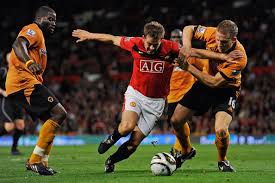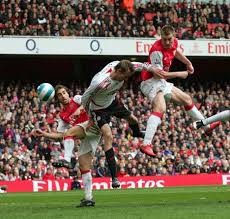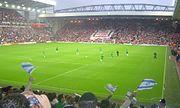 |  |  |
English Premier League
England
The Barclays English Premier League (EPL), considered as the best in the world.
Liverpool FC vs Wolverhampton Wanderers
Official name Liverpool FC
City Liverpool
Founded 1892
Club colors Red / Red / Red
vs.
0 - 0
Wolverhampton Wanderers
Official name Wolverhampton Wanderers FC
City Wolverhampton
Founded 1877
Club colors Old Gold / Black / Old Gold
Match scheduled:
Date: 26-12-2009
Time: 17:30 until 19:30
Week 19 / Round 19 :: Barclays Premier League 2009/2010

Liverpool F.C. was founded after a dispute between Everton and John Houlding, the leaseholder of Anfield and Everton director. Fundamental difference emerged in how the club should be run when the club assessed the purchase of the whole of the Anfield site. Houlding was accused of motives for personal financial gain. Everton who had been playing at Anfield for eight years departed from Houlding and Anfield moving to a new stadium in Goodison Park.[1][2]
Liverpool F.C. were founded by Houlding to play at the vacated Anfield. The original name was to be Everton F.C. and Athletic Grounds, Ltd., or Everton Athletic for short, but it was changed to Liverpool F.C. in June 1892 when The Football Association refused to recognise the team as Everton.[3]
The club won the Lancashire League in their first season, and successfully applied to join the Second Division for the following season. They won the league and were promoted to the First Division. They won their first title in 1900–01, and were champions again in 1905–06. They reached their first FA Cup final in 1914 but lost 1–0 to Burnley.[4] The club won back-to-back championships in 1921–22 and 1922–23, but after this the club did not win another trophy until 1946–47 when they won the League for a fifth time. The club reached the FA Cup final in 1950, but lost to Arsenal. Liverpool were relegated to the Second Division in the 1953–54 season.[5] During this period they suffered a 2-1 FA Cup defeat against non-league Worcester City FC in the 1958-59 season.
Not long after this infamous result, Bill Shankly was appointed manager and released 24 players. He also converted a room at Anfield originally used for boot storage into a room where the coaches could talk strategy over tea (and other beverages). There Shankly, along with other founding Boot Room members Joe Fagan, Reuben Bennett, and Bob Paisley, started reshaping the team.[6]

Fagan resigned after the disaster and Kenny Dalglish was appointed as player-manager.[13][14] During his reign, the club won another three League Championships and two FA Cups, including a League and Cup "Double" in 1985–86. Liverpool's success was overshadowed by the Hillsborough Disaster: in an FA Cup semi-final against Nottingham Forest on 15 April 1989, hundreds of Liverpool fans were crushed.[15] 94 fans died that day; the 95th victim died in hospital from his injuries four days later, and the 96th died nearly four years later without regaining consciousness. After the Hillsborough tragedy there was a governmental review of stadium safety. Known as the Taylor Report, it paved the way for legislation which required top-division teams to have all-seater stadiums. The report ruled that the main reason for the disaster was overcrowding due to a failure of police control.[16][17] Dalglish cited the Hillsborough Disaster and its repercussions as the reason for his resignation in 1991. He was replaced by former player Graeme Souness. Apart from winning the FA Cup in 1992, Souness achieved little success and was replaced by a former member of the "Boot Room", Roy Evans. Evans fared little better: a League Cup victory in 1995 was his only trophy. One highlight was a 4-3 victory over Newcastle United at Anfield on 3 April 1996, which was named in April 2003 as the Match of the Decade in the Premier League 10 Seasons Awards. Gérard Houllier was appointed as co-manager in 1998–99, but was left in sole charge after Evans resigned in November 1998.[18]
Liverpool has played at Anfield since they were founded in 1892. Anfield was built in 1884 on land adjacent to Stanley Park, and was originally used by Everton.[34] They left the ground in 1892 over a dispute about rent with the owner of Anfield, John Houlding, who decided to form a new club to play at the ground. The capacity of the stadium was 20,000, although only 100 spectators attended Liverpool's first match at Anfield.[35]
In 1906, the banked stand at one end of the ground was formally renamed the Spion Kop[36] after a hill in Natal. The hill was the site of the Battle of Spion Kop in the Second Boer War, where over 300 men of the Lancashire Regiment died, many of whom were from Liverpool.[37] At its largest, the stand could hold 28,000 spectators, and was one of the largest single tier stands in the world. Many stadia in England had stands named after the Spion Kop, but Anfield's was the largest Kop in the country at the time; it was able to hold more supporters than some entire football grounds.[37] The stand was considerably reduced in capacity due to safety measures brought in following the Hillsborough Disaster. It was completely rebuilt as an all-seater stand in 1994, and remains a single tier stand with a reduced capacity of 12,390.[35]

The Anfield Road stand is positioned at the opposite end to the Kop, and houses the away team's fans. Rebuilt in 1998 with a capacity of 9,074, it is the newest stand at Anfield. The two stands adjacent to these are the Main Stand, with a capacity of 12,227, and the Centenary Stand, which has a capacity of 11,762. The Main Stand is the oldest part of Anfield, and has remained largely untouched since its redevelopment in 1973. It houses the players' changing rooms and the director's box, and the dug-outs are in front of the stand. The Centenary Stand was previously known as the Kemlyn Road Stand until it was rebuilt for the club's centenary in 1992. The redevelopment saw the houses in Kemlyn Road demolished and the address become non-existent. The capacity of the stadium is 45,362. It is rated as a four-star stadium in the UEFA Stadia List.[38]
On 30 July 2004, the Liverpool City Council granted the club planning permission to build a new 60,000-seat stadium just 300 yards (270 m) away from Anfield at Stanley Park,[39] and on 8 September 2006 the Council agreed to grant Liverpool F.C. a 999-year lease on the land on the proposed site.[40] Following the takeover of the club in February 2007 by George Gillett and Tom Hicks, the proposed stadium was redesigned. In November 2007, the new design was approved by the Council, and preparation of the site started in June 2008.[41][42] HKS, Inc. are to build the new stadium.[43] No construction has taken place as the owners have been unable to finance the project.
Despite Morgan's arrival, the 2007–08 season ultimately brought more disappointment as the club failed to match the previous campaign's playoff finish. Poor form around Christmas saw them slump to midtable and only a late rally, aided by the goal power of new signing Sylvan Ebanks-Blake, put them back in the promotion hunt. They finished just outside the final play-off spot on goal difference, one goal short of Watford.

The 2008–09 season saw the club's strongest start since 1949–50, as an opening day draw preceded a run of seven consecutive wins. Fired by the goals of Ebanks-Blake and new signing Chris Iwelumo, the club hit the top of the table for the first time in years by the end of August and never left the automatic promotion spots after. A second run of seven consecutive wins tightened their grip on the lead by Christmas.
Despite a dismal start to 2009, the equally faltering form of their rivals allowed Wolves to retain the top spot. March saw a return to form with 13 points from a possible 15, strengthening their position at the top of the table that they had led since October. Promotion to the Premier League was finally confirmed on 18 April 2009 with a 1-0 win over Queens Park Rangers. The following week, Wolves clinched their first divisional title since the 1988–89 season.
Wolverhampton Wanderers have played at Molineux, Whitmore Reans, since 1889. Their previous home was in the Blakenhall area, and although no signs of the ground remain, a nearby road is called Wanderers Avenue. The Molineux name originates from Benjamin Molineux, a local merchant who built his home on the grounds. Northampton Brewery, who later owned the site, rented its use to Wolverhampton Wanderers in 1889, who had previously lacked a permanent home. After renovating the site, the first ever league game was staged on 7 September 1889 in a 2-0 victory over Notts County before a crowd of 4,000.
In 1953, the stadium became one of the first to install floodlights, at an estimated cost of £10,000. The first ever floodlit game was held on 30 September 1953, as Wolves won 3-1 against South Africa. The addition of the floodlights opened the door for Molineux to host a series of midweek friendlies against teams from across the globe. In the days prior to the formation of the European Cup and international club competitions, these games were highly prestigious and gained huge crowds and interest, the BBC often televising such events.
The old South Bank at Molineux is also historically the second largest of all Kop ends closely followed by Aston Villa's Holte End, both of which regularly held crowds in excess of 30,000.











